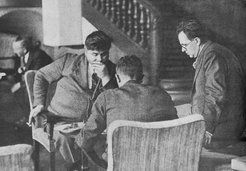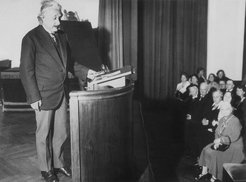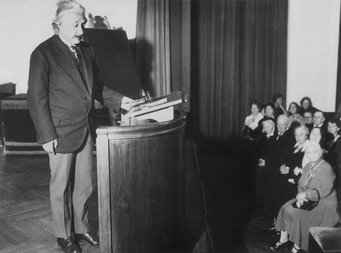Hosts & Guests
From 1929 to 1943 Harnack House ran a hotel for foreign scientists but also for diplomatic guests of the German Foreign Office. The researchers came to give guest lectures but also for longer stays as scientific fellows. Current information indicates that at least 35 Nobel Prize laureates visited Harnack House as guests between 1929 and 1943.

However, it also provided accommodation for leading politicians, artists and industrialists. The guest and event lists reflect the Kaiser Wilhelm Society’s extensive networks which were cultivated at Harnack House from 1929 onwards.
The portrait wall in the Wintergarten Hall shows 156 figures who were guests at Harnack House before its conversion to an American officers’ club, bringing an end to its first period of history as an academic guesthouse. Many of the guests were in contact with one another as colleagues working on the same topics or through personal relationships.
The installation invites visitors to explore 30 thematic paths. Each figure on the portrait wall is part of a theme’s history. Visitors will find a short biography of the person when they open the portrait boxes. For more information about the figures and their relationships with one another, simply take a card from the postcard compartment in the box.
Nobel laureates

Evidence exists that a total of 35 Nobel Prize winners visited Harnack House between 1929 and 1943, ten of whom came from abroad. Even prior to the foundation of the house, the Kaiser Wilhelm Society (KWG) had appointed a committee – primarily made up of Directors from the Kaiser Wilhelm Institutes in Dahlem – which made proposals on which foreign scientists should be invited to Berlin as fellows or guest speakers. The biochemist Carl Neuberg and the biologist Richard Goldschmidt, and also Michael Polanyi, head of department at Fritz Haber’s Institute, played a particularly active role in cultivating these relationships.
Many of the guests were already Nobel Prize laureates at the time of their invitation while others received the accolade later. Hans Fischer received the news that he had won the Nobel Prize whilst at Harnack House in 1930. The researchers who had already been awarded the Nobel Prize included the biochemists Otto Fritz Meyerhof and Otto Warburg, the physicists Max Planck, Max von Laue and Albert Einstein as well as Fritz Haber – all of whom were Scientific Members of the Kaiser Wilhelm Society. Hans Krebs visited Harnack House in 1932 as a junior scientist and though he was not presented with the Nobel Prize until much later, his career began at the KWG and in Dahlem. Konrad Lorenz, who gave a lecture at Harnack House in 1936, also only received the Nobel Prize many years later as a member of the Max Planck Society.
Adolf Butenandt and Richard Kuhn were regular visitors to Harnack House during the Third Reich. Their nomination for the Nobel Prize in 1939 and 1938 are special cases in the history of science under National Socialism as both scientists were unable to accept their Nobel Prizes because Hitler had imposed a ban on this. His reason was the decision to award the 1935 Nobel Peace Prize to the pacifist and publicist Carl von Ossietzky. Ossietzky had been arrested in 1933 as an opponent of the Nazi regime and sent to a concentration camp. A friend of Ossietzky’s had initiated a campaign from abroad, nominating him for the Nobel Peace Prize to make the case public. When it succeeded, Hitler responded by banning all German citizens from accepting the Nobel Prize. Butenandt and Kuhn received their awards after the Second World War at a time when they were already members of the Max Planck Society.













